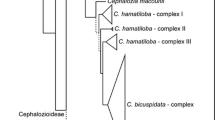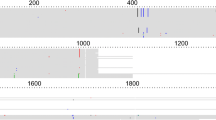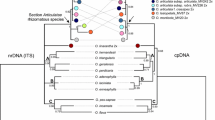Abstract
Complete sequences for the internal transcribed spacers of the 18s–26s nuclear ribosomal DNA were generated to establish phylogenetic relationships among five species of the genus Guizotia. Parsimony analysis and pairwise distance data produced a single tree with four clearly distinguished clades that accord with previously reported chromosomal data. The clades produced here have been discussed with reference to existing taxonomic treatments. It appears that Guizotia scabra ssp. scabra, G. scabra ssp. schimperi and Guizotia villosa have contributed to the origin of Guizotia abyssinica, the cultivated species of the genus. The present composition of the species of genus Guizotia and the subtribe the genus presently placed in are suggested to be redefined.





Similar content being viewed by others
References
Baagøe J (1974) The genus Guizotia (Compositae). A taxonomic revision. Bot Tidsskr 69:1–39
Baldwin B (1992) A phylogenetic utility of the internal transcribed spacers of nuclear ribosomal DNA in plants: an example from the Compositae. Mol Phylogenet Evol 1:3–16
Baldwin B, Snderson M, Porter J, Wojciechowski M, Campbell C, Donoghue M (1995) The ITS region of nuclear ribosomal DNA: a valuable source of evidence on angiosperm phylogeny. Ann Mol Bot Gard 82:247–277
Bekele E (1998) Historical and biological accounts of Ethiopia’s unique position in the domestication and utilization of plant genetic resources: Ethiopia’s gift to the world. Ethiopia’s in broader perspective, vol. III. Nakanish Printing Co. Ltd, Kyoto, Japan, pp 775–789
Bekele E, Lester RN (1981) Biochemical assessment of the relationship of Eragrostis tef (Zucc.) Trotter with some wild Eragrostis species. Ann Bot 48:717–725
Cerbah M, Souza-Chies T, Jubier MF, Lejeune B, Siljak-Yakovlev S (1998) Molecular phylogeny of the Hypochaeris using internal transcribed spacers of nuclear rDNA: inference for Chromosoma Evolution. Mol Biol Evol 15:345–354
Dagne K (1995) Karyotypes, C-banding and nuclear numbers in Guizotia (Compositae). Plant Syst Evol 195:121–135
Dagne K (2001) Cytogenetics of new Guizotia Cass. (Compositae) interspecific hybrids pertaining to genomic and phylogenetic affinities. Plant Syst Evol 230:1–11
Dagne K, Heneen WK (1992) The karyotype and nucleoli of Guizotia abyssinica (Compositae). Hereditas 117:73–83
Hiremath SC, Murthy HN (1988) Domestication of Niger (Guizotia abyssinica). Euphytica 37:225–228
Hiremath SC, Murthy HN (1992) Cytogenetical studies in Guizotia (Asteraceae). Caryologia 45:69–82
Hiremath SC, Murthy HN, Salimath SS (1992) Quantitative nuclear DNA differences associated with genome evolution in Guizotia (Compositae). Genetica 85:241–247
Humbles JE (1972) Observations of genus Seigesbeckia L. Cienc Naturaleza 13:2–19
Karis PO (1993) Heliantheae sensu lato (Asteraceae) Clades and classification. Plant Syst Evol 188:139–195
Kimura M (1980) A simple method for estimating evolutionary rates of base substitutions through comparative studies of nucleotide sequences. J Mol Evol 16:111–120
Purseglove JW (1976) The origin and migration of crops in Tropical Africa. In: Harlan J, De Wet JMJ, Stemler ABI (eds) Origin of African plant domestication. Mountain Publishers, The Hague, Paris, pp 291–309
Robinson H (1981) A revision of the tribal and subtribal limits of the Heliantheae (Asteraceae). Smithson Contrib Bot 51:1–102
Schulz DL (1990) Zur Kenntnis der Gattung Sigesbeckia L. in Africa. Gleditschia 46:613–628
Soltis DE, Soltis PS, Doyle JJ (1998) Molecular systematics of plants II: DNA sequencing. Kluwer, Dordrecht
Stuessy TF (1977) Heliantheae—systematic review. In: Heywood VH, Harborne JB, Turner BL (eds) The biology and chemistry of the Compositae, vol. 1. Academic, London, pp 1106–1118
Weiss EA (1971) Castor, sesame and safflower. Leonard Hill, London
Acknowledgements
The first author is very grateful for all the assistances provided to him by Centers for Genetic Anthropology of University College of London that kindly hosted the sequence study made. Part of the living cost for the present study was made by a grant from Sida/SAREC.
Author information
Authors and Affiliations
Corresponding author
Rights and permissions
About this article
Cite this article
Bekele, E., Geleta, M., Dagne, K. et al. Molecular phylogeny of genus Guizotia (Asteraceae) using DNA sequences derived from ITS. Genet Resour Crop Evol 54, 1419–1427 (2007). https://doi.org/10.1007/s10722-006-9126-0
Received:
Accepted:
Published:
Issue Date:
DOI: https://doi.org/10.1007/s10722-006-9126-0




